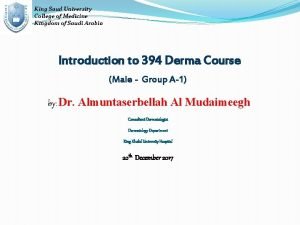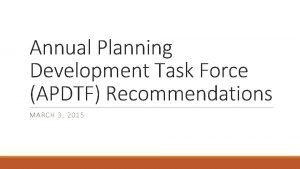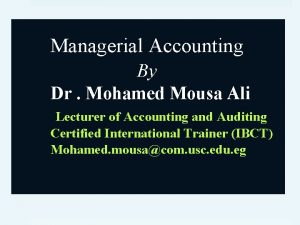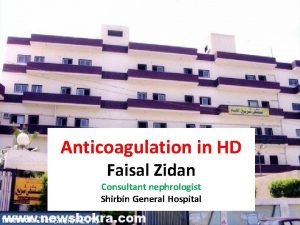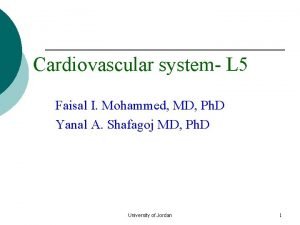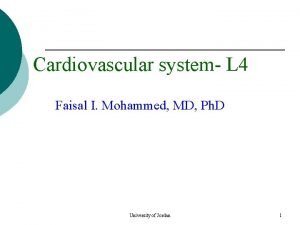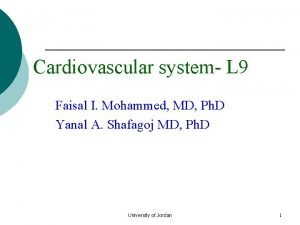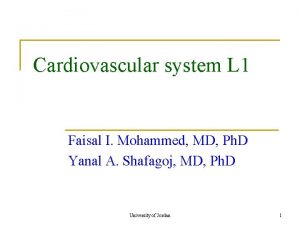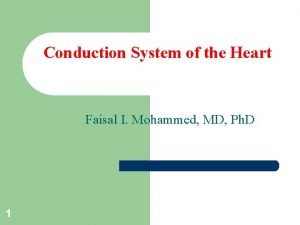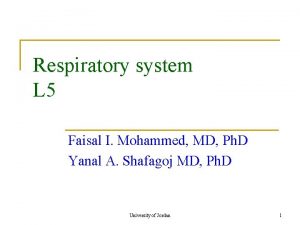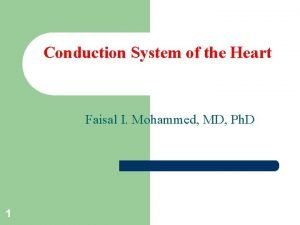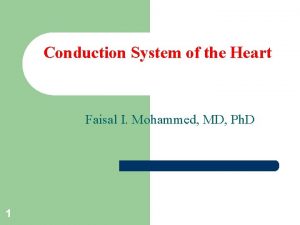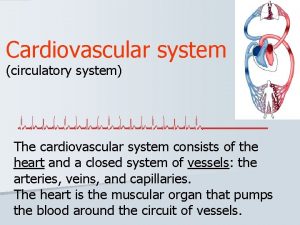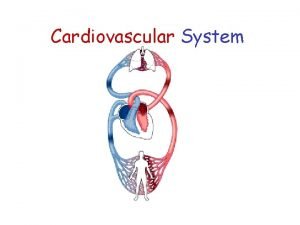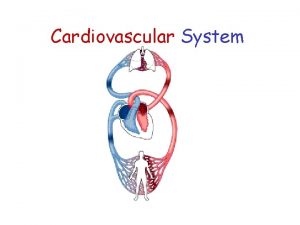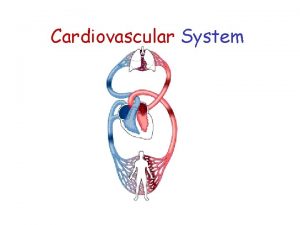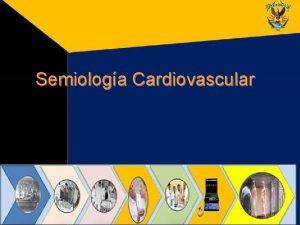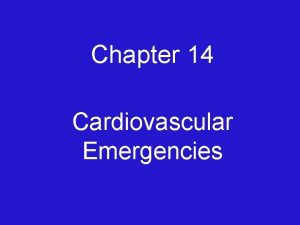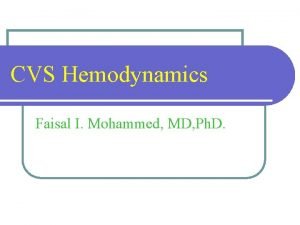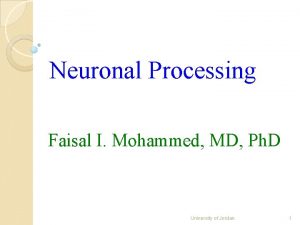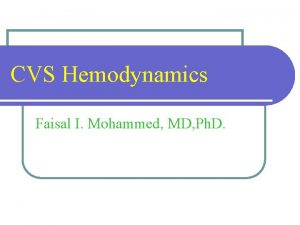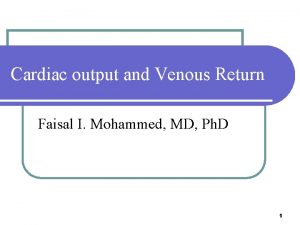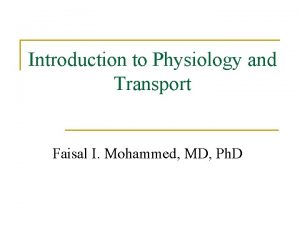Cardiovascular system L 6 Faisal I Mohammed MD

























- Slides: 25

Cardiovascular system- L 6 Faisal I. Mohammed, MD, Ph. D Yanal A. Shafagoj MD, Ph. D University of Jordan 1

The peripheral resistance: ¡ It is the resistance to blood flow through a vessel caused by friction between the moving fluid and the vascular wall. ¡ Most of the peripheral resistance to blood flow occurs in arterioles ( 50%) and capillaries ( 25%)

Velocity of Blood Flow is Greatest in the Aorta Velocity of Blood Flow = Blood Flow Cross sectional area Aorta >Arterioles> Small veins >Capillaries

Hemodynamic laws ¡ Ohm’s law: F =∆P/R l F = Flow, ∆P = Change in Pressure, R = Resistance CO = cardiac output, MAP = mean arterial pressure, TPR = total peripheral resistance. Since Rt. Atrial pressure = 0 then

Hemodynamic laws… cont ¡ Poiseuille’s law F = ∆Pr 4 / 8 L F = flow, ∆P = change in pressure r = radius of the vessel (eta) = viscosity L = length of the vessel Then Resistance, R = 8 L / r 4

Effect of Vessel Diameter on Blood Flow P= 100 mm Hg

How Would a Decrease in Vascular Resistance Affect Blood Flow? FLOW = P RESISTANCE Conversely, FLOW = P RESISTANCE

Poiseuille’s law …cont

Poiseuille’s law …cont

Blood Pressure Regulation 10

Sphygmomanometer 11

Measurement of Systolic and Diastolic Pressures ¡ Auscultatory method is the most commonly used method for measuring systolic and diastolic pressures. ¡ When cuff pressure reaches systolic pressure, one begins to hear tapping sounds in the antecubital artery; as the cuff pressure reaches diastolic pressure, one hears muffled sounds and then Korotkoff sounds disappear. ¡ Mean arterial pressure can be estimated by adding 40% of systolic pressure to 60% of diastolic pressure. 12

Blood Pressure Regulation ¡ ¡ What regulation means…narrow fluctuations What are your tools? …HR & SV& radius of art& blood volume Mean Arterial Pressure (MAP) = 1/3 systolic pressure + 2/3 diastolic pressure MAP= Diastolic Pressure+1/3 Pulse Pressure 13

Mean Arterial Pressure 14

Short term regulation of BP 1. Baroreceptors or pressoreceptos (High pressure) Carotid and Aortic Baroreceptors 15

Short term regulation of BP cont… 1. Baroreceptors or pressoreceptos (High pressure) 16

The Vasomotor Center (VMC) ¡ The VMC transmits impulses downward through the cord to almost all blood vessels. ¡ VMC is located bilaterally in the reticular substance of the medulla and the lower third of the pons. ¡ The VMC is composed of a vasoconstrictor area, vasodilator area, and sensory area.

Arterial Baroreceptor Reflex ¡ Important in short term regulation of arterial pressure. ¡ Reflex is initiated by stretch receptors called baroreceptors or pressoreceptors located in the walls of the large systemic arteries. ¡ A rise in pressure stretches baroreceptors and causes them to transmit signals to the vasomotor center (VMC) and feedback signals are sent via the automonic nervous system to the circulation to reduce arterial blood pressure back to normal. Blood Pressure Arterial Baroreceptors Vasomotor Center

Baroreceptor mechanism 19

20

Effect of Parasympathetic and Sympathetic Nervous Systems on Factors that Influence the Mean Arterial Pressure 21

Short term regulation of BP cont… Chemoreceptors 22

Carotid and Aortic Chemoreceptors ¡ Chemoreceptors are chemosensitive cells sensitive to oxygen lack, CO 2 excess, or H ion excess. ¡ Chemoreceptors are located in carotid bodies near the carotid bifurcation and on the arch of the aorta. ¡ Activation of chemosensitive receptors results in excitation of the vasomotor center. O 2 CO 2 p. H Chemoreceptors VMC Sympathetic activity BP

Nervous Control of the Heart 24

University of Jordan 25
 Epcardium
Epcardium Dr basith ali siddiqui
Dr basith ali siddiqui Uch sharif mazar
Uch sharif mazar Kfupm bb
Kfupm bb King saud university college of medicine
King saud university college of medicine Faisal jaswal
Faisal jaswal Faisal ali mousa
Faisal ali mousa Behavioral adaptations of tigers
Behavioral adaptations of tigers Said faisal aha centre
Said faisal aha centre فيصل زيدان
فيصل زيدان Blood vesel
Blood vesel What makes up the circulatory system
What makes up the circulatory system Rat cardiovascular system simulation
Rat cardiovascular system simulation Its tubular dude
Its tubular dude Cardiovascular system crash course
Cardiovascular system crash course Cengage learning heart diagram
Cengage learning heart diagram Figure 11-8 arteries
Figure 11-8 arteries Chapter 11 the cardiovascular system figure 11-10 answers
Chapter 11 the cardiovascular system figure 11-10 answers Chapter 11 the cardiovascular system
Chapter 11 the cardiovascular system Lesson 11 cardiovascular system
Lesson 11 cardiovascular system Tissues in circulatory system
Tissues in circulatory system Hypertensive atherosclerotic cardiovascular disease
Hypertensive atherosclerotic cardiovascular disease Introduction of cardiovascular system
Introduction of cardiovascular system Ptca
Ptca Anatomy and physiology unit 7 cardiovascular system
Anatomy and physiology unit 7 cardiovascular system Cardiovascular system diseases and disorders chapter 8
Cardiovascular system diseases and disorders chapter 8




